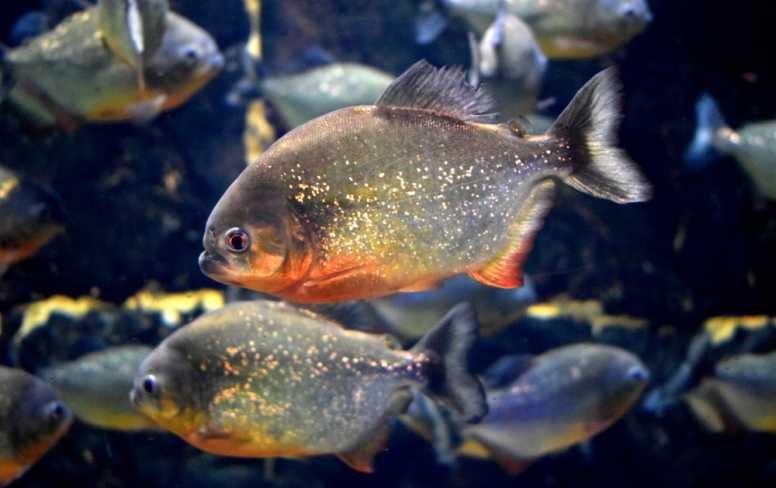Piranha

.A piranha or piraña, a member of serrasalmidae family, or a member of the subfamily Serrasalminae within the tetra family, characidae in order characiformes, is a freshwater fish that inhabits South American rivers, floodplains,
lakes and reservoirs. Although often described as extremely predatory
and mainly feeding on fish, their dietary habits vary extensively, and
they will also take plant material, leading to their classification as omnivorous.
Classification
Kingdom: Animalia
Phylum: Chordata
Class: Actinopterygii
Subclass: Neopterygii
Infraclass: Teleostei
Order: Characiformes
Family: Serrasalmida
Fun fact
1. Piranha teeth are pretty intense but replaceable
2. Piranhas have lived in South America for million years
3. Some piranhas are cannibals
Size
Depending on the exact species, most piranhas grow to between 12 and 35 cm (5–14 in) long. A few can grow larger, with the largest living species, the red-bellied, reaching up to 50 cm (20 in). There are claims of São Francisco piranhas at up to 60 cm (24 in), but the largest confirmed specimens are considerably smaller. The extinct Megapiranha which lived 8–10 million years ago reached about 71 cm (28 in) long, and possibly even 100 cm (40 in).
Morphology
Serrasalmus, Pristobrycon, Pygocentrus, and Pygopristis are most easily recognized by their unique dentition. All piranhas have a single row of sharp teeth in both jaws. The teeth are tightly packed and interlocking (via small cusps) and are used for rapid puncture and shearing. Individual teeth are typically broadly triangular, pointed, and blade-like (flat in profile). The variation in the number of cusps is minor. In most species, the teeth are tricuspid with a larger middle cusp which makes the individual teeth appear markedly triangular. The exception is Pygopristis, which has pentacuspid teeth and a middle cusp usually only slightly larger than the other cusps.
Biting abilities
Piranhas have one of the strongest bites found in bony fishes. Relative to body mass, the black piranha (Serrasalmus rhombeus) produces one of the most forceful bites measured in vertebrates. This extremely powerful and dangerous bite is generated by large jaw muscles (adductor mandibulae) that are attached closely to the tip of the jaw, conferring the piranha with a mechanical advantage that favors force production over bite speed. Strong jaws combined with finely serrated teeth make them adept at tearing flesh.
Taxonomy and Evolution
Piranhas belong to the subfamily Serrasalminae, which includes closely related omnivorous fish such as pacus. Traditionally, only the four genera Pristobrycon, Pygocentrus, Pygopristis, and Serrasalmus are considered to be true piranhas, due to their specialized teeth. However, a recent analysis showed, if the piranha group is to be monophyletic, it should be restricted to Serrasalmus, Pygocentrus, and part of Pristobrycon, or expanded to include these taxa plus Pygopristis, Catoprion, and Pristobrycon striolatus. Pygopristis was found to be more closely related to Catoprion than the other three piranha genera.
The total number of piranha species is unknown and contested, and new species continue to be described. Estimates range from fewer than 30 to more than 60.
Komentar
Posting Komentar